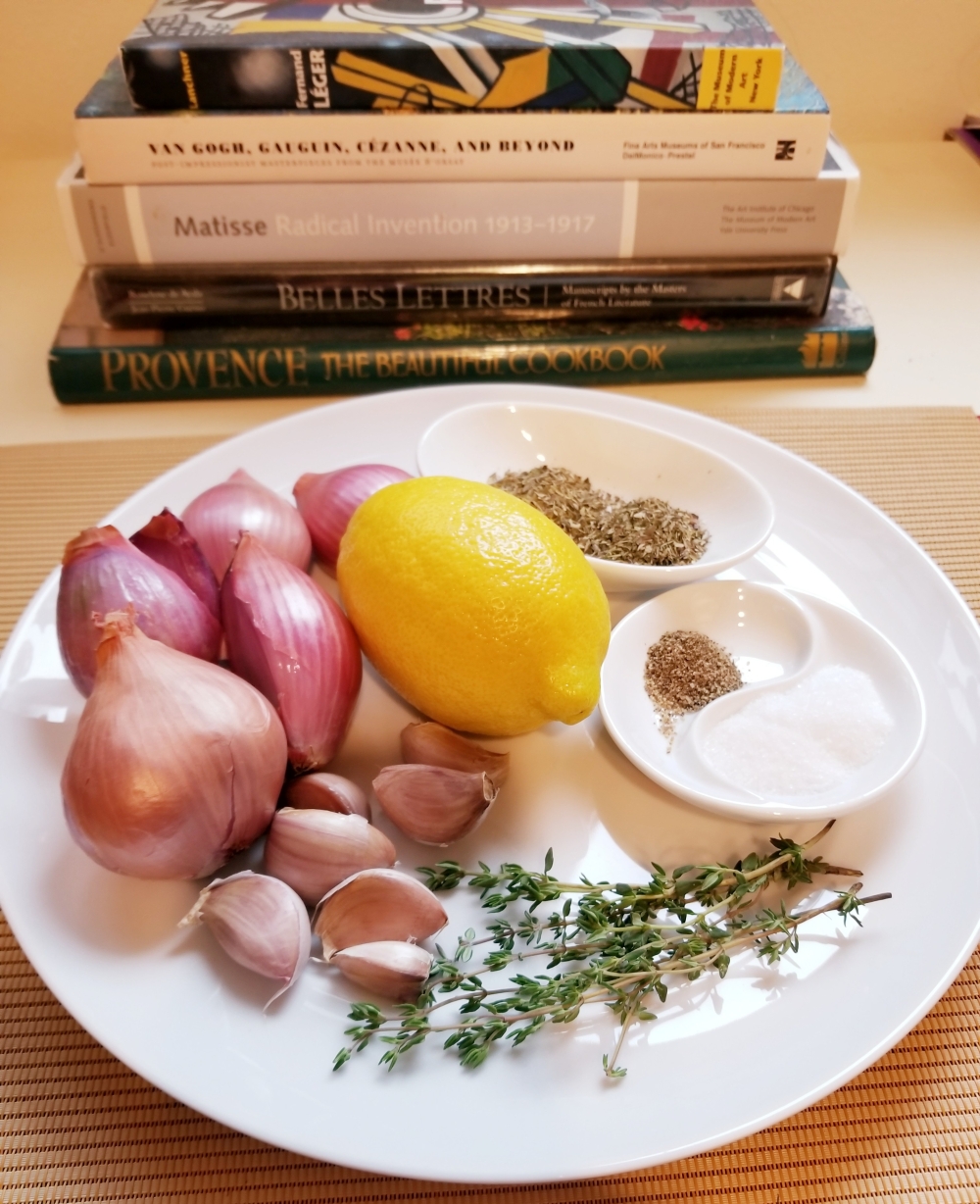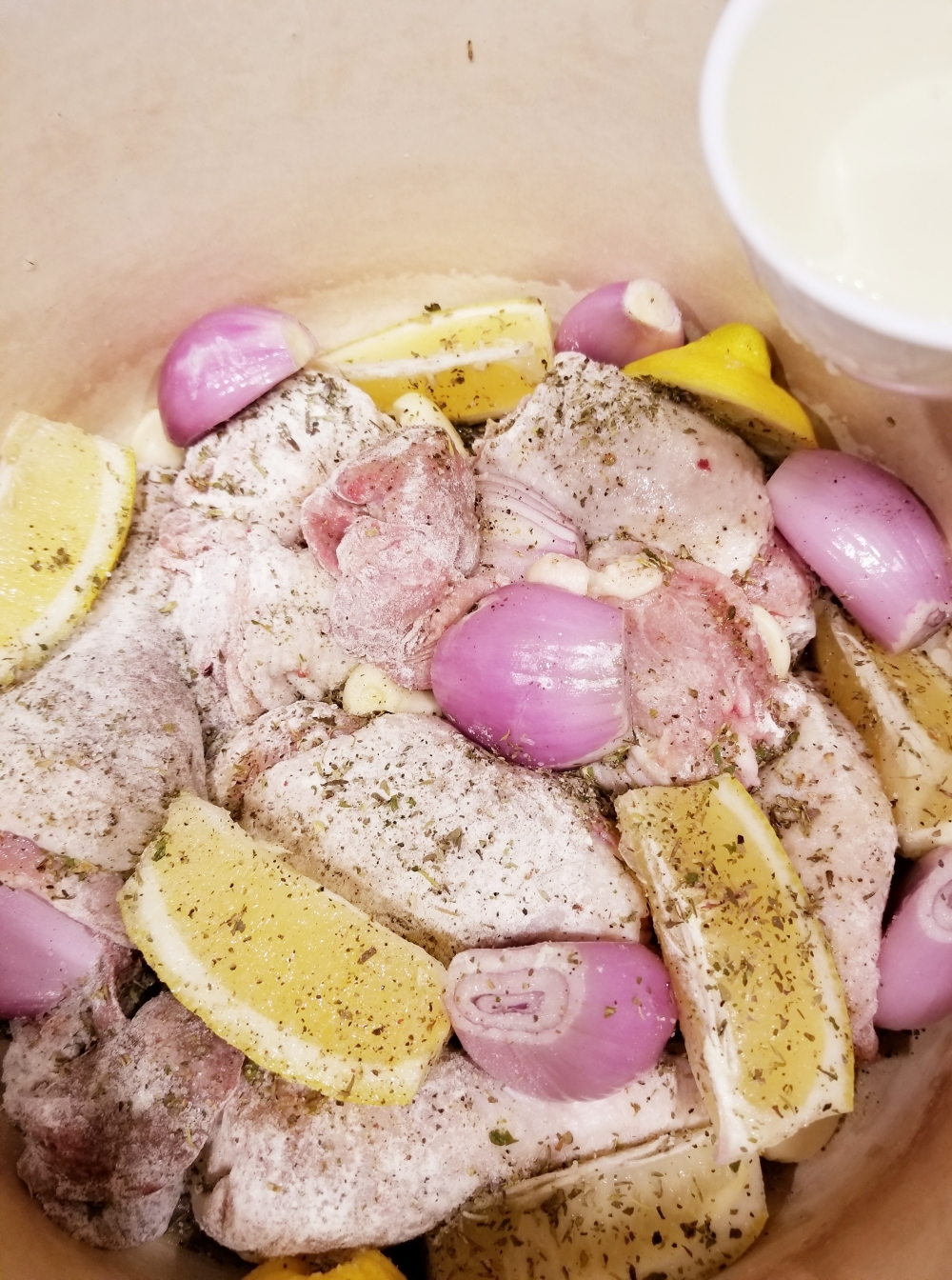
INGREDIENTS
4 chicken legs or 8 bone-in, skin-on chicken thighs
2 teaspoons kosher salt
1 teaspoon freshly ground black pepper
½ to ¾ cup all-purpose flour
3 tablespoons olive oil
2 tablespoons herbes de Provence
1 lemon, quartered
8 to 10 cloves garlic, peeled
4 to 6 medium-size shallots, peeled and halved
⅓ cup dry vermouth
4 sprigs of thyme, for serving

If you plan on visiting France in the future, a visit to the southern, sun-drenched region will surely enhance any trip. At the height of summer, French northerners flock to the beaches of the Côte d’Azur to take advantage of the fine weather. Historic cities from Roman times have their own individual appeal: Orange, Avignon, Nîmes, Marseille, Nice, and Aix-en-Provence.
Notably, artists from Vincent van Gogh and Paul Cézanne to Picasso and Matisse have drawn inspiration from this geographical area where the Mistral and Sirocco winds converge and dance on its rich limestone terroir – so suitable for olive groves, lavender fields, and vineyards.
If the north boasts its Camembert, Provence has goat and sheep cheeses: Banon and Roquefort. This region is also well known for their rosé wines such as Tavel.
Traveling with eight other French Literature and Language students from the Sorbonne several years ago, we travelled down to the areas mentioned above. After our final exam, we all decided to celebrate by purchasing a Eurail pass and touring the Provence region. One of the most memorable culinary experience I encountered was at Aix-en-Provence, our last city stop.
We arrived late at night, famished and tired. We were on the lookout for a café (if one was still open) where we could just grab a snack. As we wandered around the old part of the city, a restaurant was just about to close – the patroness was removing the chairs outside and putting them back inside the restaurant. I decided to ask if they still had some food left over that we could purchase.
“Asseyez-vous, soyez la bienvenue,” she said in a somewhat perfunctory manner…
Within moments, however, she began to bring out a salade composée with a vinaigrette dressing, baguettes, dried meats and cheeses, olives and cut-up figs and pears. You can just imagine how much food there had to be to feed nine hungry students! This genuine approachability and generosity of spirit typifies the Provencal people – this simple repast was the most memorable feast we had while in France.

I approach the Herbes de Provence roast chicken in this same spirit, as it reminds me of the people, the land, and its flavors. I remember how fragrant the air was when we walked through the lavender fields, the sunset as we walked through the park as men chatted about politics over a game of Pétanque, or sipping some rosé at a café as we watched people stroll by…. When I prepare this dish, the atmosphere of the kitchen changes as the aromatic herbes suffuse the air, and the sound of the chicken crisping as it roasts whets the appetite like nothing else!
Today herbes de Provence is taken for granted as a seasoning that is easy to buy in almost any grocery store, but until relatively recently this was not actually the case. The first books by Julia Child did not mention them by name – she only listed four or five characteristic herbs from Provence that should be used in her dishes. It was not until the 1970s that the first shrewd French businessman combined a number of herbs and began to promote them as herbes de Provence. American companies such as McCormick followed his lead, and now you find this wonderful seasoning un peu partout!
Although I can easily purchase it, I usually prefer to make my own by combining the following: thyme, oregano, sage, marjoram, rosemary, and lavender, in descending proportions. The first 5 herbs I usually measure out as 3 tablespoons, 2 tablespoons, 2 tablespoons, 1 tablespoon, and 1 tablespoon, plus ½ tablespoon of lavender. You may certainly use fresh herbs instead of dried ones; here the usual ratio is to use 1 teaspoon of fresh herbs to ½ teaspoon of dried. I change the proportions depending on whom I am dining with and what I feel best represents the moment and the meal planning I have conjured up (cheese, wine, salad choices).
To add variation to the above recipe, a tomato-based semi-stew can be created – just add 1 cup of cherry tomatoes at Step 3 (remove the seeds), along with Provencal olives (I usually add the olives at the end to keep them from getting mushy). For even more added flavor: fresh parsley and mint hint of a Northern African essence served over tabouli or couscous.

POSTSCRIPT:
I love garlic, so I used a whole head about 12 cloves
I used 4 thighs, 2 drumsticks and 1 whole breast (cut into 2 pieces) chicken
I added one tablespoon butter to the olive oil
½ to 1 cup of dry white wine can be used instead of the ⅓ cup of dry white vermouth